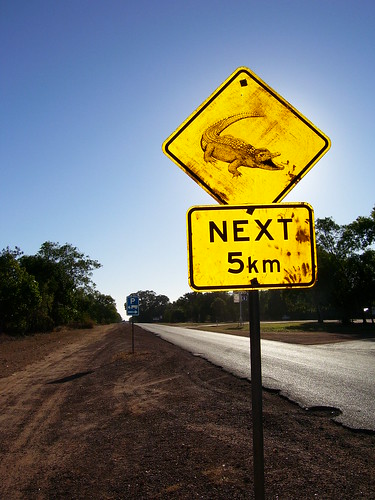 In the past two weeks I covered over 6,000kms on an Outback safari from Darwin to Adelaide via Litchfield National Park, Kakadu National Park, Katherine Gorge, the Devil's Marbles, Alice Springs, Kings Canyon, Uluru, Kata Tjuta, Coober Pedy, Port Augusta, the Flinders Ranges, Wilpena Pound, and the Clare Valley. From the Tropical North through the Red Centre to the Festival State. Whilst this involved a lot of sitting in a bus it also involved swimming in water holes, crocodile spotting, kayaking, hiking, sleeping in swags and sitting around camp fires.
In the past two weeks I covered over 6,000kms on an Outback safari from Darwin to Adelaide via Litchfield National Park, Kakadu National Park, Katherine Gorge, the Devil's Marbles, Alice Springs, Kings Canyon, Uluru, Kata Tjuta, Coober Pedy, Port Augusta, the Flinders Ranges, Wilpena Pound, and the Clare Valley. From the Tropical North through the Red Centre to the Festival State. Whilst this involved a lot of sitting in a bus it also involved swimming in water holes, crocodile spotting, kayaking, hiking, sleeping in swags and sitting around camp fires.I made the schoolboy error of assuming that I would be able to find accommodation without a problem in Darwin so I left booking it until the day of my flight. It turns out that this time of year is high season in Darwin. I worked my way through the list of hostels in the Rough Guide and ended up at Frogshollow Backpackers. A frog would be displeased to arrive here in the middle of the night. It is a hostel that was once good and has fallen into ruin. It is untidy and dirty. Litter is strewn about the place and has obviously been there for some time. The mattresses are questionable to say the least, with blood stains underneath (a sign of bed bugs). I was lucky to be in one of the few rooms with air conditioning. Darwin in the middle of winter is still humid. Luckily when we came back from the trip I was booked into the Cavennagh, which is much nicer, although if you are on the ground floor you are next to the bar area. Darwin is a pretty relaxed place, much more modern than I expected. There is a pretty beach, Mindel, which is apparently safe to swim in this time of year. During the summer they pulled out over 200 Saltwater Crocodiles from the Harbour area. Parliament is open to members of the public, there are some good museums and a few old buildings.
Whilst sitting in a bus for long periods for a sizeable portion of the 14 days may not be the most fun, some of the things that happened on the bus made it a unique trip rather than just a sight to sight dash. There was a great bunch of people on the bus and there were eight of us who were on all 3 legs of the trip together. We were rather lucky to have a legendary Japanese guy on the trip, Koshi (or as the Brits mistakenly call him Yoshi). He could start a party in a prison cell. I originally met him back in 1770 at Cool Bananas. On the first day of the trip in Litchfield we kept stopping at places for a swim and Koshi only had a towel the size of a flannel, which meant whenever he got changed he would flash everyone. As we knew this was going to happen we could turn away in time, however, other groups weren’t so fortunate. His enthusiasm for pretty much everything was infectious. His rendition of the Japanese national anthem was better than any other anthem (Canada came a distant last on the anthem stakes as they couldn’t remember the words).
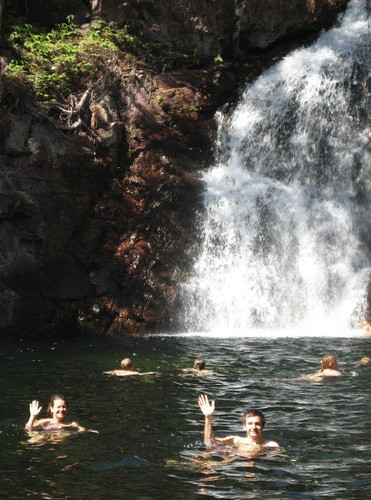 The Kakadu leg of the trip is known as the swimming trip amongst the guides. We went swimming every day. There are some amazingly beautiful spots. It felt like you were strolling or swimming through an Indian Jones film set at times. Due to it being the dry season we were able to get to all the 'attractions' that Kakadu has to offer, during the wet season it is impossible to get out there. If you choose to book a Kakadu trip during the wet season Adventure Tours won't actually take you to Kakadu. We went to Twin Falls and Jim Jim Falls. The guides on our trip had never been to Twin Falls before. Last year Twin Falls was only open to the public for 3 weeks of the year and Jim Jim Falls was only open for 9 weeks. We weren't allowed to swim at Twin Falls because the area had not been cleared of Saltwater Crocodiles. Crocodile attacks are relatively rare but they do seem to happen to German backpackers frequently. So much so that the Germans on our trip were somewhat concerned about swimming in Kakadu. If you do want a safeguard to being attacked by a Saltie then the best thing is to swim with someone smaller than you (or a German, a small German is even better) and the Crocodile will go for them. I nearly got into a spot of bother at Jim Jim. The water is ice cold as it pours off of the Arnhem Escarpment. To get to the falls you have to climb over boulders for half an hour, you then get to the first pool which you have to swim across. After that you climb over some bigger boulders to get to the pool where the waterfall pours into. In the scenic moment my brain didn't really contemplate how far it was to the waterfall. I went swimming off to it with this middle aged Dutch guy. The water was pitch black due to the depth of the pool. We got over to the waterfall without a problem. We climbed up on a ledge to get out of the water we then swam back. I hadn't realised that we had swam a good few hundred metres. So much so that on the way back I was pretty exhausted and still had a hundred metres to go. The dutch guy was in a similar predicament and there wasn't anyone who could have got out to us in time. It certainly concentrated the mind in getting back to the boulders.
The Kakadu leg of the trip is known as the swimming trip amongst the guides. We went swimming every day. There are some amazingly beautiful spots. It felt like you were strolling or swimming through an Indian Jones film set at times. Due to it being the dry season we were able to get to all the 'attractions' that Kakadu has to offer, during the wet season it is impossible to get out there. If you choose to book a Kakadu trip during the wet season Adventure Tours won't actually take you to Kakadu. We went to Twin Falls and Jim Jim Falls. The guides on our trip had never been to Twin Falls before. Last year Twin Falls was only open to the public for 3 weeks of the year and Jim Jim Falls was only open for 9 weeks. We weren't allowed to swim at Twin Falls because the area had not been cleared of Saltwater Crocodiles. Crocodile attacks are relatively rare but they do seem to happen to German backpackers frequently. So much so that the Germans on our trip were somewhat concerned about swimming in Kakadu. If you do want a safeguard to being attacked by a Saltie then the best thing is to swim with someone smaller than you (or a German, a small German is even better) and the Crocodile will go for them. I nearly got into a spot of bother at Jim Jim. The water is ice cold as it pours off of the Arnhem Escarpment. To get to the falls you have to climb over boulders for half an hour, you then get to the first pool which you have to swim across. After that you climb over some bigger boulders to get to the pool where the waterfall pours into. In the scenic moment my brain didn't really contemplate how far it was to the waterfall. I went swimming off to it with this middle aged Dutch guy. The water was pitch black due to the depth of the pool. We got over to the waterfall without a problem. We climbed up on a ledge to get out of the water we then swam back. I hadn't realised that we had swam a good few hundred metres. So much so that on the way back I was pretty exhausted and still had a hundred metres to go. The dutch guy was in a similar predicament and there wasn't anyone who could have got out to us in time. It certainly concentrated the mind in getting back to the boulders.
There is more to Kakadu then simply swimming in breathtaking waterfalls. We visited Ubirr with some of the oldest Aboriginal rock art, it is possible that these were painted 20,000 years ago. There is a great lookout here (used in Crocodile Dundee) with one of the most majestic views I have experienced. We also did a cruise along the Mary River. It has the highest concentration of Saltwater Crocodiles in the world. The reaction on the small tin boat as the 4 metre long beats simply opened their mouths was audible. We had the pleasure of watching them scramble off the banks into the water, a pleasure that quickly turned to concern as they came within a few feet of the boat before submerging. Due to it being pretty rough terrain in Kakadu we were in a big 4x4 truck. It felt like we were in a Paris-Dakar truck and we didn't hang about on the corrugated tracks getting to speeds of 100kms. Not fast enough to miss the sights of Kangaroos hopping around and Brumbies (wild horses) galloping through the bush.
 On the trip from Darwin to Alice Springs our first stop was Katherine. We went kayaking up the Katherine Gorge, which could feature in an Indiana Jones film. We kayaked along the gorge, which at the beginning seemed like a great idea until after an hour's paddle we had only got to the end of the first gorge (there are thirteen in total). We made it some way into the second and then turned back. It is pretty exhausting stuff. I wouldn't do it if you are a newly wed couple. Physical exhaustion tests your limits of politeness. Anglo-Japanese relations were tested at this point as to how best to kayak back (there really aren't that many options). I would also suggest picking the biggest and strongest person to be your partner, Steve Redgrave might be a good choice if he is hanging around.
On the trip from Darwin to Alice Springs our first stop was Katherine. We went kayaking up the Katherine Gorge, which could feature in an Indiana Jones film. We kayaked along the gorge, which at the beginning seemed like a great idea until after an hour's paddle we had only got to the end of the first gorge (there are thirteen in total). We made it some way into the second and then turned back. It is pretty exhausting stuff. I wouldn't do it if you are a newly wed couple. Physical exhaustion tests your limits of politeness. Anglo-Japanese relations were tested at this point as to how best to kayak back (there really aren't that many options). I would also suggest picking the biggest and strongest person to be your partner, Steve Redgrave might be a good choice if he is hanging around.  From Katherine we had a big day of driving down to Juno Horse Farm, near Tennant Creek. This was our first taster of the swag. The swag is a one man tent designed by Australians. It is two pieces of canvas stitched together with a sleeping mat inside. You put your sleeping bag inside and that is your bed for the night. If it rains or gets too cold you can pull a flap over your head. If you need a pillow you just put your shoes under the mat. While sleeping next to the fire seems like a good idea you don't want to get too close as spitting embers can set alight to your swag and give you an unpleasant wake-up call in the middle of the night. We were pretty lucky with the weather when we slept in swags. It didn't rain and it didn't get too cold. The coldest it got was probably down to 5 degrees. I had spoken to people who had slept around Uluru when it was sub-zero and they woke up with ice on the inside of the swag! In the summer if you wonder why your guide is sleeping on top of the trailer that is because they don't want a snake to come and join them during the night. It is also not the best idea to unroll your swag and leave it out before getting into it as it does present a nice safe environment for the various creatures to set up home.
From Katherine we had a big day of driving down to Juno Horse Farm, near Tennant Creek. This was our first taster of the swag. The swag is a one man tent designed by Australians. It is two pieces of canvas stitched together with a sleeping mat inside. You put your sleeping bag inside and that is your bed for the night. If it rains or gets too cold you can pull a flap over your head. If you need a pillow you just put your shoes under the mat. While sleeping next to the fire seems like a good idea you don't want to get too close as spitting embers can set alight to your swag and give you an unpleasant wake-up call in the middle of the night. We were pretty lucky with the weather when we slept in swags. It didn't rain and it didn't get too cold. The coldest it got was probably down to 5 degrees. I had spoken to people who had slept around Uluru when it was sub-zero and they woke up with ice on the inside of the swag! In the summer if you wonder why your guide is sleeping on top of the trailer that is because they don't want a snake to come and join them during the night. It is also not the best idea to unroll your swag and leave it out before getting into it as it does present a nice safe environment for the various creatures to set up home.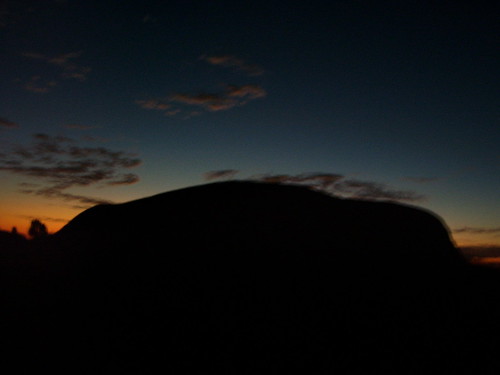 Uluru is a pretty spectacular sight. Our first sighting of it was with the sun rising as we drove from the Yulara camp site to the base for a walk around it. Somewhat controversially the Japanese guy was going to climb it which is frowned upon by the Aboriginals and most people besides. As it turned out it was too windy for him to climb it anyway. When you walk around Uluru there are certain parts that you are not allowed to take photos of because they are sacred spots. There are signs up advising you of this but it is disappointing to see people taking photos anyway whether out of ignorance or carelessness. I was quite surprised to see so many trees around the base. The area around Uluru is quite green, I had imagine it would be just red soil all around. What makes Uluru geologically interesting is that it is the world’s largest monolith (single piece of rock). They do have a cultural centre here which is pretty good but as ever there weren’t any Aboriginals working there. We also did a walk through part of Kata Tjuta (the Olgas). They are really strange to look at. There is a classic tourist image of them but I didn’t realise how spread out and vast they are.
Uluru is a pretty spectacular sight. Our first sighting of it was with the sun rising as we drove from the Yulara camp site to the base for a walk around it. Somewhat controversially the Japanese guy was going to climb it which is frowned upon by the Aboriginals and most people besides. As it turned out it was too windy for him to climb it anyway. When you walk around Uluru there are certain parts that you are not allowed to take photos of because they are sacred spots. There are signs up advising you of this but it is disappointing to see people taking photos anyway whether out of ignorance or carelessness. I was quite surprised to see so many trees around the base. The area around Uluru is quite green, I had imagine it would be just red soil all around. What makes Uluru geologically interesting is that it is the world’s largest monolith (single piece of rock). They do have a cultural centre here which is pretty good but as ever there weren’t any Aboriginals working there. We also did a walk through part of Kata Tjuta (the Olgas). They are really strange to look at. There is a classic tourist image of them but I didn’t realise how spread out and vast they are.
The bus fun really peaked on the trip from Alice to Adelaide. The guides were young and still really enjoyed their jobs. They went that bit extra for us rather simply going from A to B and whilst the two previous guides hadn’t been bad these guys were exemplary. We stopped at the road side attempting to catch Emus. We ran up sand dunes to catch a sunset. We waved off the other coaches after the Uluru sunset and then drove round serenading those who were left with “Stand by Me”. We then got to the campsite and serenaded those at the campsite with “Stand by Me”. In general if there was someone we could sing “Stand by Me” to then we would. A running gag was taking pictures of people while they slept and avoiding the dreaded Vegemite for being last on the bus.
Coober Pedy is by far the most unique place I have visited on my travels. It is in the desert on the route between Alice and Adelaide. The scenery is truly remote, it is flat without any vegetation for hundreds of kilometres around. Coober Pedy exists because of opals. Along the highway are mounds of earth that have been excavated and noodled to find opals. A local law means that only individuals can mine these lands and it has stopped big companies coming in and excavating the whole area. In town lots of the homes have been carved into the rock, so that the residents can escape the 50 degree heat in the summer. It was used in the Mad Max films and feels like a lifetime away from anything else I have experienced.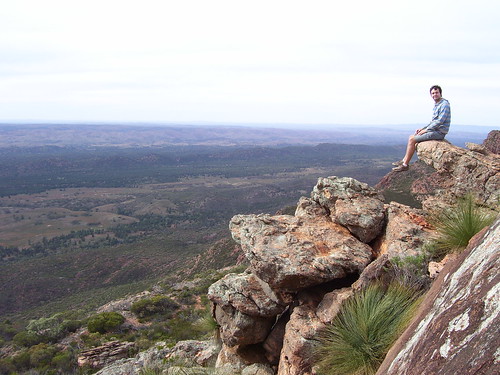 The Flinders Ranges are really beautiful. They are on par with parts of New Zealand and they could easily have stood in as backdrops for Lord of the Rings. It is such a contrast to come down from the flat vastness of Coober Pedy to then see the Flinders slowly rise up and then be amongst them. The views were superb and the drive along the winding roads was great. I could easily have spent longer here. We stayed next to Wilpena Pound and the next day climbed up to the top of the rim of what appears to be a vast crater. It was by far the toughest walk on the trip. It was 2kms up and took two and a half hours. The walk (and at times climb) was one of the highlights of the 14 days.
The Flinders Ranges are really beautiful. They are on par with parts of New Zealand and they could easily have stood in as backdrops for Lord of the Rings. It is such a contrast to come down from the flat vastness of Coober Pedy to then see the Flinders slowly rise up and then be amongst them. The views were superb and the drive along the winding roads was great. I could easily have spent longer here. We stayed next to Wilpena Pound and the next day climbed up to the top of the rim of what appears to be a vast crater. It was by far the toughest walk on the trip. It was 2kms up and took two and a half hours. The walk (and at times climb) was one of the highlights of the 14 days.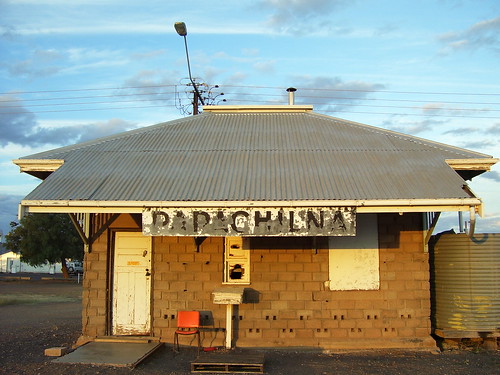 The final night of the trip was spent at Parachilna. A tiny outback village. On one side in the distance are the Flinders Ranges and on the other is nothing. Parachilna’s claims to fame are the Prairie Hotel Pub and that the world’s longest front pulled train passes the town twice a day. It carries coal to the power station in Port Augusta. We ran outside during dinner to catch a sight of this in the dark and I can confirm that it is a long train. For dinner we had Kangaroo cutlets, Emu burgers and Camel sausages. There is a school but there aren’t any children because an old woman in town scared the families away by wielding a shotgun. When we arrived one of the girl’s said, “Are we actually staying here?” and seemed quite incredulous that we were. I thought it was great because it was such a run down place and that gave it character. One evening was more than enough time though. The Prairie Hotel is owned by a family originating from the Isle of Man and they brew their own beer and use the Three Legs of Man as their logo.
The final night of the trip was spent at Parachilna. A tiny outback village. On one side in the distance are the Flinders Ranges and on the other is nothing. Parachilna’s claims to fame are the Prairie Hotel Pub and that the world’s longest front pulled train passes the town twice a day. It carries coal to the power station in Port Augusta. We ran outside during dinner to catch a sight of this in the dark and I can confirm that it is a long train. For dinner we had Kangaroo cutlets, Emu burgers and Camel sausages. There is a school but there aren’t any children because an old woman in town scared the families away by wielding a shotgun. When we arrived one of the girl’s said, “Are we actually staying here?” and seemed quite incredulous that we were. I thought it was great because it was such a run down place and that gave it character. One evening was more than enough time though. The Prairie Hotel is owned by a family originating from the Isle of Man and they brew their own beer and use the Three Legs of Man as their logo.
The final day was pretty relaxed as we cruised down from the Flinders to Adelaide via the Clare Valley wine region. We stopped at Seven Hills Winery for some tasting. Once we got into the Flinders it had got pretty chilly. It is the middle of winter on the bottom of the world. We arrived in Adelaide on what felt like a typical English Autumn day. Chilly, wet, and windy. I did this 14 day trip with Adventure Tours and would recommend it. They do a variety of trips across Australia. We stayed in a variety of accommodation, from swags to hostels and huts. The food was excellent and everyone pitched in to help prepare and cook. It does make a difference if the trip is only half full. For the last six days we had a half full bus and as such everyone could stretch out. For Kakadu and on to Alice we had the full twenty four people and this meant that the bus was crowded and that there weren't any leftovers from the food. I would recommend booking any tour with them through Peter Pans Noosa. I managed to get a couple of hundred dollars off the brochure price. I would suggest giving any of the backpacker travel agents a call before booking directly with the company because they are bound to be able to get you a discount out of their commission.